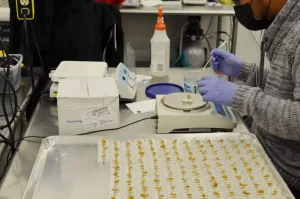
Safety should always be a top priority, no matter which cannabis extraction method processors prefer.
Extraction labs must understand and implement safety standards appropriate for their extraction processes, said Casey Flippo, CEO of hemp processor Natvana LLC and medical marijuana extraction company Dark Horse Medicinal Inc., in Little Rock, Arkansas.
Flippo said he once visited a butane hash oil (BHO) hydrocarbon lab without ventilation or a Class 1, Division 1 (C1D1) room, a manufacturing space designed to ventilate potentially flammable gases and built with fire-suppressing materials. A C1D1 room is required in hydrocarbon extraction labs.
“It was like a Molotov cocktail in the middle of the warehouse,” Flippo said.
Hydrocarbon extraction is considered the most dangerous extraction method, with the potential to blow up if the highly flammable solvents used during the process leak and ignite.
Not just BHO
But while hydrocarbon extraction raises the most safety concerns, all of the most commonly used extraction methods have safety risks.
Carbon dioxide (CO2) extraction risks carbon monoxide poisoning if a leak occurs. Ethanol is also highly flammable and can create a flashpoint if enough vapors leak into the air. Rosin is considered the safest extraction method, although burns are possible.
Additional health hazards in cannabis production include breathing of cannabis dust, hearing loss from loud equipment, and skin and eye exposure to harsh chemicals and cleaning products.
But if labs are designed and built correctly—and properly run—safety risks are significantly reduced. To ensure safety in their facility, extractors should consider three points when setting up a new lab facility:
- Facility design.
- Employee training.
- Personal Protective Equipment (PPE).
Lab facility design
Proper facility design can head off accidents, said Liz Geisleman, chief brand officer at 710 Spirits Extraction Products, a Colorado company providing solvents and supplies to extraction labs.
Make sure to have proper ventilation and that it’s located in the right spot, Geisleman said. Some gases are heavier than air, so they should be ventilated at the bottom. In addition, alarms to spot gas leaks, whether odorless CO2, or the butane or propane used in hydrocarbon processing, are critical.
A good consultant well-versed in extraction should help a processor navigate fire department regulations and help come up with a safe facility design, including if the lab is required to install a safety room as required by the chosen extraction method.
JD Garrick, managing partner of Illuminated Extractors, a Colorado company selling hydrocarbon extraction equipment, advises getting a third-party certified engineer to review design plans. This is especially important for hemp processors, which may not have established rules to follow that are as strict as the regulations marijuana processors must follow.
Having a third-party certification assures that “somebody has signed off on it as being safe to work in these environments,” Garrick said.
Proper employee training
Make sure employees are trained in all products and processes, following Occupational Safety and Health Administration (OSHA) standards, Garrick said.
“Anytime you’re dealing with a solvent, whether it’s flammable or not, you need to understand the SDS (safety data sheets) for what hazards are attached to that solvent,” Garrick said.
Geisleman agrees. Employees should “understand whatever chemistry you’re using,” she said.
In some cases—especially for hydrocarbon and CO2 labs—it may be appropriate to have specially trained technicians to run the equipment. Following OSHA guidelines will keep facilities up to date with ongoing employee training and facility safety maintenance.
Don’t forget the PPE
“Whether you’re talking about hydrocarbon or solventless in any lab setting, your PPE has to be on point,” Nick Tanem, founder of Essential Extracts, a California solventless extraction company, said of personal protective equipment.
Even beyond the harsh chemicals used in solvent-based extraction methods, employees are exposed to harsh cleaning chemicals, as well as dust and terpenes that can be dangerous.
Nitrile powder-free gloves, eyewear and ear protection (when applicable) should be provided.
PPE also helps keep labs clean and products safe from contamination, Tanem said.


